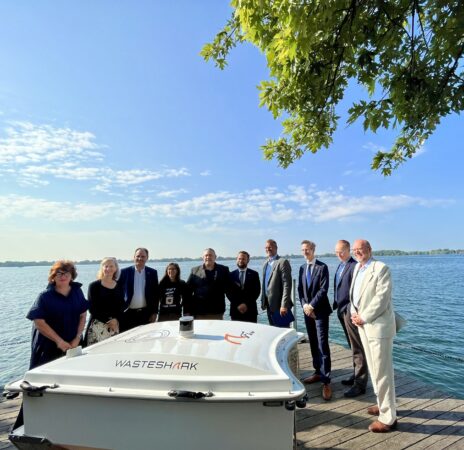
PortsToronto launches Canadian debut of WasteShark aquadrone
by CM staff

Two WasteShark aquadrones join PortsToronto's network of Seabins in capturing floating debris and small plastic pollution from the surface of the water.

Photo: CNW Group/PortsToronto.
TORONTO— PortsToronto, in partnership with RanMarine Technology, launched a pilot program that saw two WasteShark aquadrones make their Canadian debut in the Toronto Harbour. As part of PortsToronto’s larger Trash Trapping Program, two new WasteSharks, Ebb and Flow, will join PortsToronto’s network of Seabins in capturing floating debris and small plastic pollution from the surface of the water.
This pilot was made possible through a grant initiative supported by the Ministry of Foreign Affairs of the Netherlands, which supports demonstration projects, feasibility studies, or investment preparation projects that contribute to the United Nations’ Sustainable Development Goals (SDGs).
“The WasteShark aquadrone is the latest addition to our successful Trash Trapping Program, which has removed hundreds of thousands of pieces of plastic pollution and debris from the Toronto Harbour and Lake Ontario since 2019,” said RJ Steenstra, President and CEO, PortsToronto. “These aquadrones offer exciting new capability within our network of trash trapping devices in the Toronto Harbour, allowing a nimble response to floating debris that will complement the Seabins already deployed along the waterfront. We look forward to continuing this important work with program partners, in particular our longstanding research partnership with the University of Toronto Trash Team and the International Trash Trap Network that will ensure these devices contribute to global data collection and waste diversion efforts.”
The WasteShark aquadrone is designed to collect floating debris from aquatic environments and operates in a similar fashion to a Roomba-like vacuum in a home. A versatile tool, the WasteShark can operate manually by remote control and can be programmed to operate autonomously along a prescribed route using an online dashboard.
With a 180-litre capacity, the robot can collect and remove 1100-lbs of waste daily from the aquatic environment.
PortsToronto introduced Ebb and Flow, whose names were chosen through a public contest and vote earlier this year. Based out of the Outer Harbour Marina, Ebb and Flow will troll problem areas for debris collection throughout the Toronto Harbour and waterfront, collecting debris and contributing to important data collection as part of PortsToronto’s research partnership with the University of Toronto Trash Team and their International Trash Trap Network.